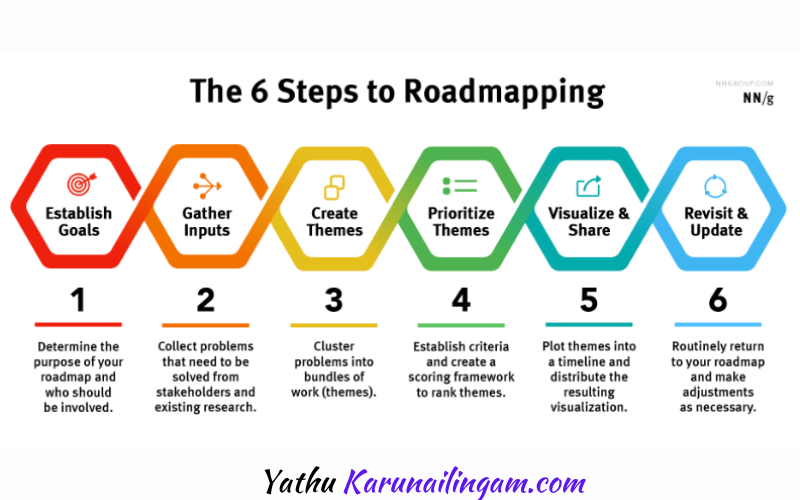- September 22, 2024
- by uyuwh
- Blog
- 0 Comments
It can be difficult to navigate the product development world. It’s like steering a boat through turbulent water. It’s easy for you to lose track of your destination when a multitude of ideas, opinions from stakeholders, and market needs collide. The product roadmap is a tool that helps teams navigate this complexity. It provides clarity and direction. It’s not enough to list features and deadlines. You need to strike the right balance of detail and flexibility.
Many organizations struggle with effectively managing product roadmaps. Many organizations drown in details, or leave crucial information vague and hard to understand for their team members. It is important to master “just enough” detail that will inspire iterative cycles of development without stifling progress or creativity. We’ll dive into the characteristics of a successful roadmap for products and discuss how to implement it in your organization.
Table of Contents
What is a Managing Product Roadmap?
A product roadmap is an important visual representation of the vision and direction your product will take over time. It defines the main deliverables, features and milestones to guide teams towards their goals.
Imagine it as a blueprint of what you are trying to create. It aligns stakeholders by providing clear priorities and timelines.
There are many different formats for road maps. Some are very high-level and in broad strokes while others go into greater detail. Your audience’s requirements and the complexity level of your project will often determine the format you use.
A well-crafted road map can serve as a tool for communication and motivation in your team. It allows flexibility for adapting to new market conditions or insights as they emerge.
The importance of Managing Product Roadmaps
It is important to manage product roadmaps in order to align teams and stakeholders. This ensures that everyone is aware of the goals and vision for a product. It creates transparency during the development process when done well.
A well-structured road map is a guide. It allows you to prioritize your tasks and allocate resources more efficiently. Clarity fosters collaboration between departments from marketing to engineering.
Managing Product Roadmaps also helps in adapting to changes in the market. Flexibility becomes more important as customer needs change. A dynamic roadmap allows for teams to quickly pivot without losing sight their goals.
It also improves communication among team members and with external partners. Everyone is kept informed of progress and changes in direction through regular updates.
By demonstrating to stakeholders that their input throughout the development process is valued, a consistent management of product roadmaps will improve stakeholder satisfaction.

Challenges of Managing Product Roadmaps
Managing product roadmaps is a complicated task. Balancing expectations of stakeholders is one major challenge. Different departments have different priorities which can cause conflicts.
A constantly changing landscape is another issue. It can be difficult to keep up with planned features and timelines when new competitors and emerging technology are introduced.
Insufficient data can also cause teams to struggle in making informed decisions. It’s difficult to determine if a roadmap is aligned with customer needs without solid metrics and feedback mechanisms.
Communication is another challenge. A misalignment of cross-functional teams may result in fragmented effort that hinders progress towards shared goals. To keep everyone on the same track, collaboration and constant updates are required.
The roadmap can become overly complex. Over-detailed roadmaps can confuse team members and hide key objectives. This will ultimately slow down the development cycle.
Product Owner Vs Product Manager – Key Differences Learn At YathuKarunailingam
The Role of Iterative Development Cycles in Product Roadmaps
Iterative development cycles play a crucial role in shaping effective product roadmaps. The teams can adapt their approach to real-time feedback. It leads to features that are more relevant and directly address the needs of users.
Teams can quickly deliver value by breaking down projects into smaller units. Each iteration is an opportunity to evaluate, allowing for early identification of gaps or areas that need improvement.
These cycles also foster collaboration between teams from different disciplines. Designers, developers and stakeholders are continuously engaged throughout the entire process. This interaction encourages transparency and aligns business goals.
Iterative development reduces the risks that come with long planning phases. The roadmap will also evolve as priorities change, ensuring that it is a dynamic document that can guide progress without being overwhelmed with details.
How to Create a Successful Product Roadmap with Just Enough Details?
Clarity and focus are essential for creating a successful roadmap. Begin by defining the vision. What problem do you solve? Prioritizing features is easier when you know what problem you are solving.
Then, identify key milestones aligned with your goals. These objectives should be more high-level than detailed. This keeps the team engaged while still allowing for some flexibility.
Early in the process, incorporate user feedback. Engagement with stakeholders will ensure that the roadmap reflects market needs and real needs.
Visual tools can help you to convey information quickly. Charts and diagrams are great for expressing complex ideas without having to overwhelm the reader with details.
As development advances, revisit and update your roadmap regularly. Flexibility is key, so make sure to adapt as new insights or priorities change.
Encourage collaboration between teams that are involved in the execution of a roadmap segment to promote ownership and alignment.
How to Manage Product Roadmaps Successfully with Iterative Development Cycles?
Engage stakeholders as early as possible. Regular communication can help align expectations and keep everyone on the same track. Use simple visuals for key updates.
Prioritize each cycle of development. This reduces confusion and allows teams to focus their energies on important tasks. This makes it easier for teams to adapt if new insights are discovered.
Plan with flexibility. Iterative cycles will bring about changes; it is important to be open to making adjustments.
Use feedback loops effectively. Gather feedback from team members or users after each iteration to improve upcoming features. This will ensure that the product is based on actual needs, rather than assumptions.
Keep it short and concise. It is possible to use a concise record of all decisions as a guide without overloading team members with unnecessary information. In addition, learn how much do product managers make from our website.
Case Study: Company X’s Effective Use of This Approach
Company X had significant challenges in the product development process. The traditional roadmaps of Company X were rigid and often led to misalignment in teams with market needs. They decided that it was time to make a change.
They encouraged better communication between departments by implementing a road map that gave just the right amount of detail. This change encouraged collaboration and enabled the team to quickly adapt based on feedback from users.
Company X has learned to embrace flexibility through iterative cycles. Each sprint gave insights that informed the next steps in their product strategies. Their roadmaps were less cluttered, allowing them to focus more on what was important: delivering value for customers.
The results were impressive. Company X improved both the speed and quality of their delivery, while still maintaining strategic goals. Their success serves as a model for other companies looking to improve their product management practices.
Conclusion
It is difficult to manage product roadmaps without too many details. This allows teams to be flexible and aligned towards strategic goals.
Emphasizing iterative development cycles fosters innovation. This encourages constant feedback and refinement to ensure products meet real needs.
Those companies that adopt this model see an improvement in teamwork. As everyone strives to achieve shared goals, clear communication is essential.
The key to success is maintaining an open-minded mindset. Accept changes and adapt plans according to the insights gained during each stage of development.
Case studies provide valuable insights into effective roadmap management. Observing how others handle their challenges can help you develop tailored strategies.
FAQs
What is a roadmap for a product?
A product roadmap is an outline of the direction, vision and progress your product will make over time. It is a document that guides stakeholders and aligns teams around what must be done.
Why is it important to manage product roadmaps?
Effective management will ensure alignment between cross-functional teams. A well-maintained road map helps prioritize tasks, while still allowing for flexibility based on feedback or market changes.
What are the challenges I may face when managing my product roadmap?
Among the challenges that arise are scope creep, misalignment of teams or stakeholders and difficulty in communicating updates. It can be difficult to balance detail without overwhelming your team.
What is the impact of iterative development on my roadmap?
Iterative development allows continuous improvement by making incremental changes based upon user feedback. This adaptability allows for the roadmap to be refined and kept relevant with new information.
What are the key points to creating a product roadmap that is effective and contains just enough detail?
Focus on the high-level goal rather than a long list of tasks. Visuals such as charts and graphs can be used to clearly communicate progress while remaining flexible to any adjustments that may be needed.
What are some examples of businesses that have successfully used this approach?
Agile methodologies are used by many tech giants in their roadmapping process. Company X used minimal documentation paired regular stakeholder checks-ins to increase efficiency and innovative outcomes.





